SnailsAttack
Hazard to Others
  
Posts: 163
Registered: 7-2-2022
Location: The bottom of Lake Ontario
Member Is Offline
|
|
Unidentified copper salts
The attached files are a gallery of pictures I took of two unknown crystal species produced by evaporation of a mixture of sodium chloride and
copper(II) acetate.
I suspect that they're double salts, since the colors and structures bear no resemblance to any of the 4 traditional salts that could be formed from
such a mixture. Impurities are unlikely.
Species 1 - "strudelite"
- vibrant blue-green. named for the fact that they look to me like they should be called strudels
- possess a fungal or almost coral-like structure. amorphous. highly disinclined to intersect with neighboring strudels as it grows.
- easy to isolate and recrystallize (see picture 4). does not seem inclined to reseparate into its constituents
- featured in pictures 1a, 1b, 3, 4, 5 (large growth only).
Species 2 - "faux azurite"
- deep blue. named for the fact that it looks a hell of a lot like spheroidal azurite, but readily dissolves in water
- possess a structure reminiscent of some species of calcium acetate crystals
- seems to separate on recrystallization (into what?)
- featured in pictures 2, 5 (upper wall growths only).
further testing required.
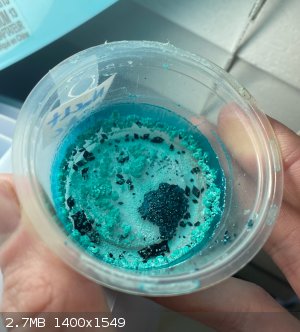 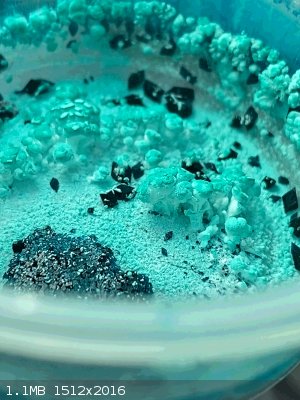 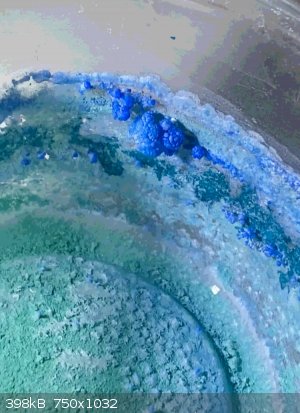 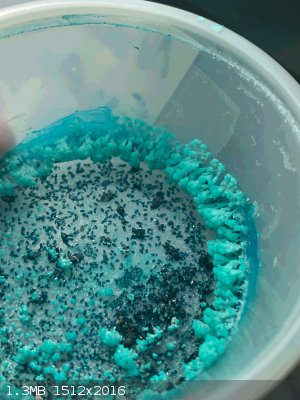 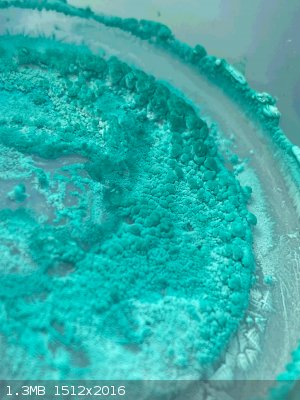 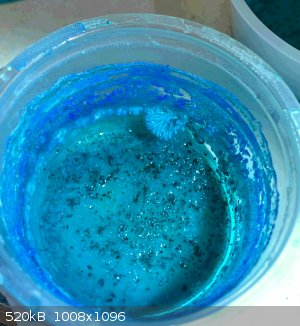
|
|
|
woelen
Super Administrator
        
Posts: 7976
Registered: 20-8-2005
Location: Netherlands
Member Is Offline
Mood: interested
|
|
The dark crystals spots in the green material is copper(II) acetate. I have made copper(II) acetate myself and it has exactly that dark green color.
The paler green stuff most likely is impure table salt, having a lot of copper(II) in it. The copper(II) looks like partially hydrated and partially
coordinated to chloride (e.g. the complex CuCl2(H2O)2, which has a cyan/green color).
The blue species actually surprises me. If you only starting materials are copper(II) acetate and sodium chloride, then it really surprises me that
you get such bright blue compounds. This blue color is the color of purely hydrated copper(II), without coordination to acetate or chloride ion. But
in the mix of salts you use, that seems nearly impossible for me.
So, the four green pictures do not surprise me at all, but the two blue pictures do.
|
|
|
SnailsAttack
Hazard to Others
  
Posts: 163
Registered: 7-2-2022
Location: The bottom of Lake Ontario
Member Is Offline
|
|
oh yeah those ones are unmistakable
Quote: Originally posted by woelen  | | The paler green stuff most likely is impure table salt, having a lot of copper(II) in it. The copper(II) looks like partially hydrated and partially
coordinated to chloride (e.g. the complex CuCl2(H2O)2, which has a cyan/green color). |
yeah that's what I'm thinking as well
Quote: Originally posted by woelen  | | The blue species actually surprises me. If you only starting materials are copper(II) acetate and sodium chloride, then it really surprises me that
you get such bright blue compounds. This blue color is the color of purely hydrated copper(II), without coordination to acetate or chloride ion. But
in the mix of salts you use, that seems nearly impossible for me. |
you're right that is really weird. maybe some hydroxides snuck into there somehow due to hydrolysis of one of the copper salts? i gotta make more of
this stuff
|
|
|
Fulmen
International Hazard
    
Posts: 1693
Registered: 24-9-2005
Member Is Offline
Mood: Bored
|
|
Copper chemistry is messy, it forms hydrates, gels and basic salts of varying proportions depending on conditions. Trying to identify solid crud like
that is pretty hopeless.
We're not banging rocks together here. We know how to put a man back together.
|
|
|
SnailsAttack
Hazard to Others
  
Posts: 163
Registered: 7-2-2022
Location: The bottom of Lake Ontario
Member Is Offline
|
|
Quote: Originally posted by Fulmen  | | Copper chemistry is messy, it forms hydrates, gels and basic salts of varying proportions depending on conditions. Trying to identify solid crud like
that is pretty hopeless. |
challenge accepted
|
|
|
Fulmen
International Hazard
    
Posts: 1693
Registered: 24-9-2005
Member Is Offline
Mood: Bored
|
|
Knock yourself out, son :-)
We're not banging rocks together here. We know how to put a man back together.
|
|
|
Amos
International Hazard
    
Posts: 1406
Registered: 25-3-2014
Location: Yes
Member Is Offline
Mood: No
|
|
I encountered that brilliant, almost royal blue species once when I accidentally boiled copper(II) acetate solution to dryness, no sodium chloride
included but it did utilize tap water. At the time I thought it may have been calcium copper acetate from the calcium in my somewhat hard Kentucky
water. It definitely has a similar color. I would expect that beautiful pale turquoise material to contain copper, sodium, and chloride ions, but not
acetate.
|
|
|
DraconicAcid
International Hazard
    
Posts: 4278
Registered: 1-2-2013
Location: The tiniest college campus ever....
Member Is Offline
Mood: Semi-victorious.
|
|
I'd expect a carbonate to be that blue colour....
Please remember: "Filtrate" is not a verb.
Write up your lab reports the way your instructor wants them, not the way your ex-instructor wants them.
|
|
|
Amos
International Hazard
    
Posts: 1406
Registered: 25-3-2014
Location: Yes
Member Is Offline
Mood: No
|
|
Well that's incredibly simple to test, just see if it effervesces in dilute acid
|
|
|
Fantasma4500
International Hazard
    
Posts: 1677
Registered: 12-12-2012
Location: Dysrope (aka europe)
Member Is Offline
Mood: dangerously practical
|
|
you wanna keep some samples around of lead, copper, barium etc so test for precipitate
if theres sulfate in it, you will get a positive with barium, where hydroxide and chloride wont
you can try isolating it a bit since the CuAc has quite low solubility, heating it up, seeing if it changes color before decomposing- if it does
decompose at all
adding some HCl to it, if its CuCl2 and its all concentrated should yield you a nice deep green color, which is tetrachloride complex
complexing it with ammonia may give you some guesses
you should probably at this point just isolate the CuAc, NaOH it and heat it to 100*C to get CuO and use that for whatever- reacts in seconds with HCl
try to keep some notes on what contents is in which beaker, ive had to sort through what- 50 small bags of various chemicals, some of them having
absolutely no idea what they are, luckily pricey stuff tends to react a bit differently with most reagents.
|
|
|
AJKOER
Radically Dubious
    
Posts: 3026
Registered: 7-5-2011
Member Is Offline
Mood: No Mood
|
|
OK, based on my experience per the Wikipedia on the interaction of NaCl and Cuprous, as noted here in Eq (6) https://en.wikipedia.org/wiki/Dicopper_chloride_trihydroxide , I point to a related reaction between NaCl and Cupric noted here https://www.quora.com/What-happens-when-you-mix-sodium-chlor... , to quote:
"The solution will be blue due to the hydrated copper(II) ion: [Cu(H2O)6]^2+. But if you added a substantially greater amount of NaCl you will get a
different complex ion: [CuCl4]^2- which is yellow. But since not all of the hydrated copper ions are converted there will be a mix of “blue” and
“yellow” which makes a “green” solution. "
Hence, the green coloration.
|
|
|
MineMan
National Hazard
   
Posts: 998
Registered: 29-3-2015
Member Is Offline
Mood: No Mood
|
|
Chrysicolla and azurite. Some copper acetate left over.
|
|
|
Amos
International Hazard
    
Posts: 1406
Registered: 25-3-2014
Location: Yes
Member Is Offline
Mood: No
|
|
Yeah totally. An insoluble silicate mineral popped up from an aqueous solution with no silicon. And another insoluble mineral well known for being
quite unstable at room temperature and pressure also decided to. And I guess the chloride ions just decided to merge with the void? Great work.
[Edited on 2-23-2022 by Amos]
|
|
|
SnailsAttack
Hazard to Others
  
Posts: 163
Registered: 7-2-2022
Location: The bottom of Lake Ontario
Member Is Offline
|
|
Quote: Originally posted by Amos  |
Yeah totally. An insoluble silicate mineral popped up from an aqueous solution with no silicon. And another insoluble mineral well known for being
quite unstable at room temperature and pressure also decided to. And I guess the chloride ions just decided to merge with the void? Great work.
[Edited on 2-23-2022 by Amos] |
I’ve had sodiums merge with the void before when I made dicopper chloride trihydroxide (or something similar) from copper metal in a saltwater bath.
|
|
|
SnailsAttack
Hazard to Others
  
Posts: 163
Registered: 7-2-2022
Location: The bottom of Lake Ontario
Member Is Offline
|
|
Attached are some more pictures of the strudelite and faux azurite, which I've realized are less distinguishable from one another than I thought.
In one of these pictures, the double salts actually appear to have failed to generate. There are standard copper acetate crystals growing imbedded in
some amorphous sodium chloride.
I have confirmed that everything in these samples is water-soluble and comprised exclusively of sodium, copper, chloride and acetate ions.
Let the headscratching continue.
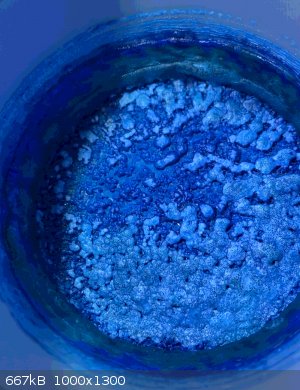 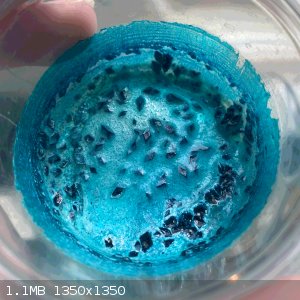 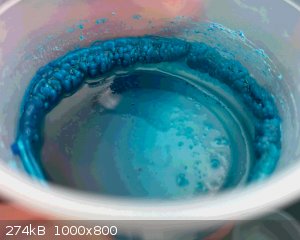 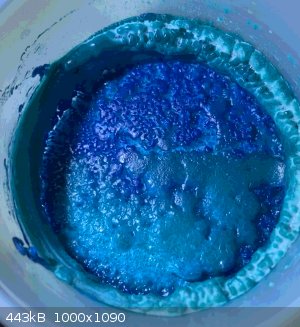
|
|
|